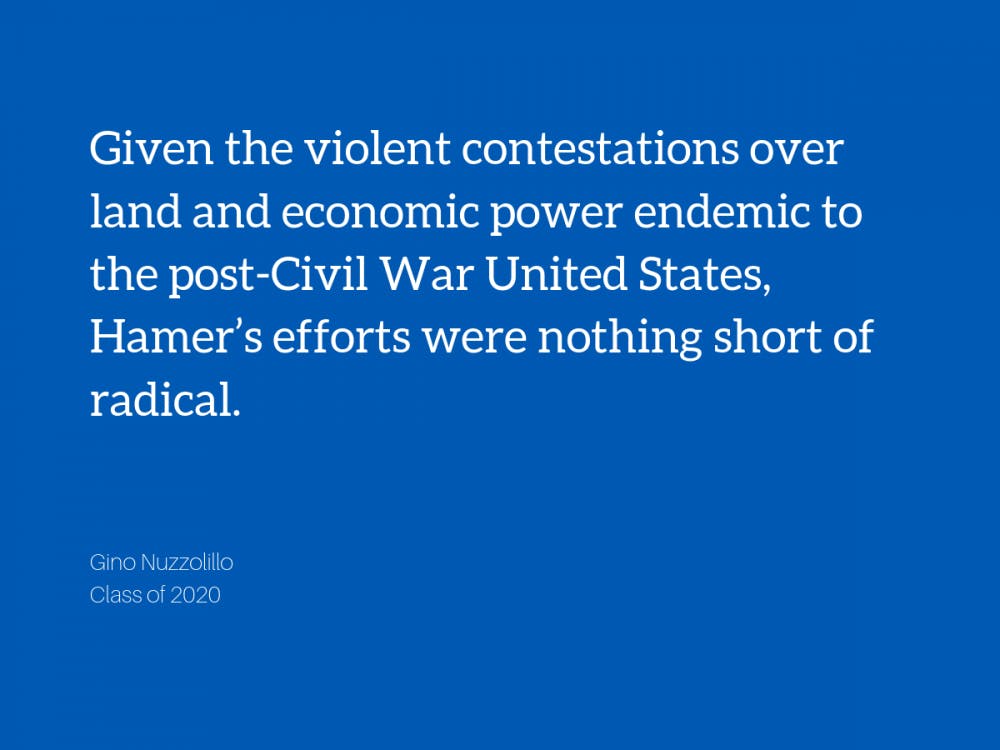This week, I want to talk about Fannie Lou Hamer. But first, let’s talk about land.
The end of the Civil War officially marked the emancipation of 4 million enslaved people in the United States. For the first time in 246 years, these newly freed individuals could leave the plantations, travel, reunite with their families, and set the terms for their work, time, and energy outside the slaveholder’s authority. But freedom contained another promise: that of “40 acres and a mule” for freed men and women.
The federal government promised the redistribution of millions of acres, stretching from eastern North Carolina to the Mississippi Delta, to those who could now, finally, capture a slice of the astronomical wealth their labor had helped coax from the land. The promise appeared real—South Carolina, for example, established a Land Commission to assign land to formerly enslaved people. Land in 1866 meant self-sufficiency and independence from white rule, a source of stability absent the (nominal) security of voting rights or equal protection under the law. W.E.B. DuBois described this “land hunger” as “an absolutely fundamental and essential thing to any real emancipation of the slaves.” To a certain extent, African Americans realized this dream—by 1910, Black-owned farmland in Mississippi totaled 2.2 million acres, the most of any state.
The white South, however, could not tolerate Black prosperity and independence. Their growing resistance to Reconstruction led to the closure of the Freedmen’s Bureau in 1872 and the removal of federal troops from the South after the election of 1876. That is, the federal government caved to the Redeemers and abandoned Black communities. In turn, the former planter class, alongside Democratic politicians, employed intimidation, violence, lynchings, deceptive contracts, and the criminal justice system to dispossess and displace Black landowners. The vast majority of rural Black folks became sharecroppers tied by debt to white landowners; if entangled in prisons and jails, they became convicts leased for their labor. Lynchings and violence, in particular, chipped away at every gain made by Black farmers and landowners—from the one hundred Black farmers murdered in Leflore County, Mississippi at the turn of the 20th century to the brutal suppression of a fledgling sharecroppers’ union in Hernando, Mississippi in 1935. White Southerners sought to eradicate the Black claim to equal rights, economic opportunity, and dignity; by the 1960s, exploitation and subordination of Black Southerners, especially in the fertile lands of the Mississippi Delta, remained entrenched.
This brings me back to Fannie Lou Hamer, a sharecropper living in Sunflower County, Mississippi in 1962 when organizers with the Student Nonviolent Coordinating Committee (SNCC) arrived to register Black voters. Hamer had already endured both poverty and the notorious “Mississippi appendectomy,” a forced sterilization robbing her of the ability to have children. The SNCC organizers radicalized Hamer, who drew from her lived experiences to become a powerful organizer and essential to the movement to challenge white supremacy in Mississippi. When her first effort to register voters at a courthouse in Indianola failed, her boss fired her and confiscated her family’s property. Undeterred, Hamer then rose to prominence as a co-founder of the Mississippi Freedom Democratic Party to rival the segregationist Mississippi Democrats and build a base of Black political power in the state. Charlie Cobb, a SNCC activist, called Hamer a “crabgrass politician,” someone who came to realize that she does not have to be bound by any system; rather, she was a weed, “a threat to the harmony and continuity of a carefully trimmed lawn.” In other words, Hamer was a troublemaker.
As a sharecropper, the land of the Mississippi Delta was foundational to how Fannie Lou Hamer understood herself and the movement for Black liberation. In 1969, in the same places where Black Mississippians feared lynching and white supremacist violence, where freedpeople had struggled for land ownership, Hamer purchased 40 acres of prime Delta land, which she used to establish the “Freedom Farm Cooperative.” The Freedom Farm Cooperative modeled the idea of “food sovereignty” by and for poor Black families in Sunflower County, and members approached land use communally so that each participant had a stake in the cooperative’s governance. Collective ownership of the land also meant that Hamer and the Freedom Farm families had complete control independent of any white authority. Over 1,500 families belonged to the Freedom Farm, and they sustained themselves by growing cash crops and vegetables; by 1970, the Farm had purchased an additional 640 acres and started a “pig bank” to ensure poor families had access to meat. Hamer even ensured that 200 units of low-income housing were built on the land in addition to forming other co-op businesses. Although the FFC faded by the mid 1970s, the Freedom Farm briefly revived the promise of emancipation—a grasp at justice extinguished by the failures of Reconstruction-era America. Given the violent contestations over land and economic power endemic to the post-Civil War United States, Hamer’s efforts were nothing short of radical.
I believe Fannie Lou Hamer’s politics dramatically upend how we understand economics, land, power, democracy, and citizenship in the American South. Echoing Du Bois and following the trail shaped by both the enslaved and the freed, Hamer understood that poor people, especially poor Black communities, deserved a shot at a decent life governed by no one else but themselves. More, Hamer understood liberation as collective, where people’s freedom was bound up in the freedom of others. Work in the tradition of Fannie Lou Hamer continues today in Mississippi and across the South, exemplified by organizations like Cooperation Jackson in Jackson, Mississippi. Hamer’s legacy, then, pushes us to discard the notion of a monolithic, racist, “backwards,” South, to instead understand the South as the site of both oppression and resistance, complexity and clarity, constantly in flux as a bellwether for democratic experiments and the expansion of who counts in the United States.
Gino Nuzzolillo is a Trinity senior. His column runs on alternate Thursdays.
Get The Chronicle straight to your inbox
Signup for our weekly newsletter. Cancel at any time.

